.
Hopliten: Griechische Rüstungen, Schilder, Brustpanzer, Helme, Waffen
The main purpose of armour, after all, is not to protect the wearer, but to make him think he is protected, Nick Sekunda
Part 1 - 2

Early Sixth or late 7th century BC. Inside of an hoplite shield with the central arm band (porpax). The shield (Aspis) today is called hoplon which is a general name in Greek for weapon. It was made by wood covered by bronze. Inside covered with leather. The weight around 8 kg. The shield was decorated with different images sometimes with a Gorgon head. Often the symbol Lambda is used as a decoration by the Spartans (initial of Lacedaemon) or the symbol M by the Messenians. The drawings could be sometimes extremely complex if we believe Homer's discussion about the Shield of Achilles (image of a part drawn and text with description). I can imagine that the opponent fighter was irritated for a few seconds by this complexity and Achilles used these moments in his favor :-)
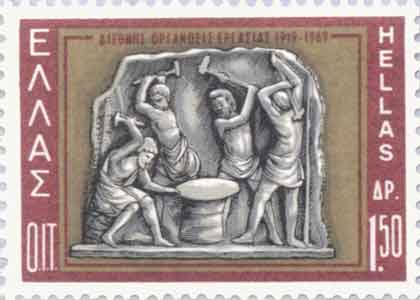
Production of the Shield of Achilles
Actually it shows the god Hephaestus with three Cyclopes producing armor
Bronze votive shield, Delphi, Greece

Achilles with a shield with additional protection for the legs , 480 BC Triptolemos Painter
Metal was expensive and therefore only a thin metal coating was used for the shields but : We are told that the shields fabricated (only in Syracuse) during this season (399-398 BC) of assiduous preparation were not less than 140000 in number, and the breast plates 14000, many of them unrivalled in workmanship, destined for the body-guard and the officers. George Grote, Sicily during the despotism of the Elder Dionysius at Syracuse. History of Greece. In a period of 2 centuries an estimated number of 100000 helmets have been dedicated only in Olympia.


A warrior with a Corinthian Helmet and a Boetian Shield. The helmet was decorated on the top with a crest of horsehair that looks like a brush. Probably not used often even if shown in many pottery images.
Running warriors with shields and spears. Red-figured crater.500-490 BC. Interesting is the shield version of the right warrior

Some Saian mountaineer
Struts today with my shield.
I threw it down by a bush and ran
When the fighting got hot.
Life seemed somehow more precious.
It was a beautiful shield.
I know where I can buy another
Exactly like it, just as round., Archilochos,
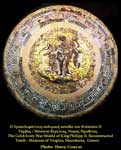
War Shield of King Phillip II,
Argyraspides : Macedonian soldiers who carried shields covered with silver plates, some officers of the Argyraspides: Antigenes , Teutamus, (similar units used by the Seleucids and Alexander Severus who included also chrysoaspides "golden shields")
Hephaistos polishing the shield of Achilles, Dutuit Painter c. 480 BC., Red Figure Amphora, Museum of Fine Arts, Boston
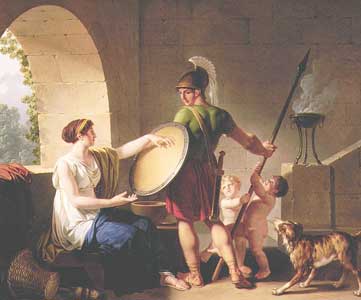
Spartan woman giving the shield to her son, Jean-Jacques-Francois Le Barbier ( 1738-1826), Portlandmuseum . I tan i epi tas
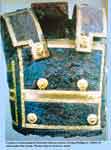
Thorax Armor of King Phillip II
Thorax (Iron composite Cuirass, probably the only almost intact version that survived) of Philip II of Macedon , father of Alexander the Great, Vergina Greece. (See also the Helmet found)

Greaves (leg guards) protecting the leg from the knee to the ankle, Bronze 6th Century BC, Archaic, Olympia.

Bronze greaves BM GR1856.12-26.615
Greaves Denda Staatliche Antikensammlungen 4330.
Argyraspides, Macedonian soldiers who carried shields covered with silver plates

The Greaves of Achilles
Greaves or in Greek Knimis, The greaves made of flexible metal and lined with felt, leather or cloth, were "sprung on" the leg, and then fastened behind by straps or buckles. Like the cuirass, they were mde to fit the individual person. (White and Morgan, illustrated dictionary of Xenophon's Anabasis)
Elephenor, offspring of Ares, son of Chalcodon,
great-hearted leader, commanded the Abantes,
who live to breathe war's fury, soldiers from Euboea,
Chalcis, Eretria, wine-rich Histiaea, Cerinthus by the sea,
men from the steep fortress Dium, Carystus, and Styra.
These swift Abantes came with Elephenor, [540]
their hair grown long behind, warrior spearmen,
filled with fierce desire to tear apart their enemies,
to pierce armed bodies with their long ash spears.
Homer, Iliad Book 2

Spear Head

Spear End
The spear (dori, pl. dorata), 2 versions used by the hoplites one to be hurled the other for hand to hand fight. The spear carried in the right hand (from which the epi dori ie to the right is derived). Some other commands: ta dorata epi ton dexion omon ehein (keep the spears at rest on the right shoulder) and ta dorata eis probolin kathentas (lowering the spears for the charge)
Some Images of Greek Armor from the German Museum in Karlsruhe (Shields, Helmets, Spears...)
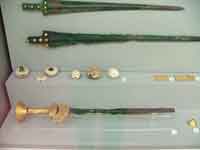
Light-armed warriors were called gumnites i..e naked.
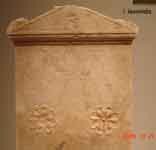
Minos just sent me, Antigenes to the islands of happy people, as I had got fatal wounds on the head and my body was pricked from spears, at the moment that the goddess of war (Enyo) encouraged me during the infantry battle against the Aitolians....

"Apo Doratos Anapidan", "from the spear jumping on a horse"
The Phalanx (pl. Phalanges) (Gr. Finger, anatomically the bones of the toes and fingers) (soldiers in close order), refers to the soldiers’ spears thrusting out from the main body like fingers from a palm.
There is a debate how the phalanx was used. Usually scholars try to interpret the ancient sources, fragments of texts of various ancient authors or pottery decorations. One common theory considers the Phalanx as a human battering-ram. The first row probably with young strong warriors, the older or weaker in the back rows. Probably 8 rows of warriors on the average but also a Phalanx depth of 40 or more was reported. Initially the phalanx moved slowly, then moving fast (ephodos) trying to keep the formation. The fight between two phalanges assumed to be like a collision in which the first phalanx row pushing with the shields (“othismos”, also with the support, physical and psychological, of the other rows) and using their spears (“doratismos”) to kill the men of the opposite front, tried to break-up the formation of the enemy phalanx.
A critical report about this theory: Phalanx against Phalanx (automatic Russian to English translation).
...when the trumpet sounded, they advanced arms and charged. And then, as they went on faster and faster, at length with a shout the troops broke into a run of their own accord, in the direction of the camp. As for the barbarians, they were terribly frightened; the Cilician queen took to flight in her carriage, and the people in the market left their wares behind and took to their heels; while the Greeks with a roar of laughter came up to their camp. Now the Cilician queen was filled with admiration at beholding the brilliant appearance and the order of the Greek army (Phalanx); and Cyrus was delighted to see the terror with which the Greeks inspired the barbarians. Xenophon, Anabasis
750-650 BC: fighting tactic uses 'phalanx' of 'hoplites' in armor, wielding iron weapons. The Phalanx was a column formation of heavy infantry carrying long spears, or pikes, and swords. Pheidon of Argos defeated with his hoplites the aristocratic warriors of Sparta at the Battle of Hysiae in 669 BC. The Phalanx and hoplites system was adopted by many Greek city states and it produced changes in the political system in Greece.
Tactics and armour was important for the Marathon battle victory. Some historian say that it was 11 or 12 September 490 BC when the Greeks attacked the Persian army in Marathon. (New studies suggest even 1 month earlier). Among the hoplites the poet Aeschylus. The problem is that the hoplite has to carry around 30 kg and is thus not very fast like a Persian soldier. The Greek phalanx moved slowly in formation towards the Persian army. The Persians assumed that they can break the Greek phalanx with their archers when the Greeks approached at 400 meters distance, in the range of the Persian artillery. This distance was used also in the so-called Hoplitodromos a event of the Olympic Games since 520 BC with warriors running with full equipment. At this distance the Greek Phalanx moved as fast as possible, even if it is difficult to keep the formation intact. The Persian archers could not open holes in the phalanx wall. With their better armour the Greeks were able to surround the larger number of Persians who in Panic tried to reach their ships and many were killed close to the beach. The victory was one of the most important historic events for the Western civilization.
A sloped Phalanx version with a strong left wing was used by the Theban general Epaminondas. Philip II and his son Alexander the Great using a longer spear increased the Phalanx average depth to 16. Smaller shields were used and the Macedonian Phalanx was more flexible supported by cavalry and catapult devices. Giant Siege Engines were used by Alexander and his successors. The result of the use of catapults and Siege Towers was an improvement of the fortification of cities.

A mourning warrior in front of the shield and a Thracian helmet of a killed friend (The soldier cuts a lock of his hair ). Oinokles Painter, scence from a Lekythos.
Far from home he (Patroculs) has fallen, dead in a strange land, with no quiet grave. My hand did not help him in his hour of need—now is the world empty of all delight. I have brought no promised bounty to Patroclus or to my comrades, so many slaughtered in battle by Hector. I stay here, alone by my ships, sitting, a useless burden on earth, who in fight has no peer among the Achaeans. But some are wiser than me. How now shall I pray? That strife among men may perish? And anger too—Anger that seeps like smoke through the soul. Anger that tastes sweeter than honey. Anger that makes even a virtuous man harden his heart—even so did Agamemnon infect me with anger. And yet—no more. It’s over. I now must force my soul into subjection, go fight for the Achaeans. I will find Hector, who has slain my dear friend, and face what my fate is. Achilles in Homer's Iliad
Shove your shield in the face of the enemy, hating life and embracing death’s dark spirits like the sun’s rays . . . Tyrtaeus, Spartan poet


a) Construction of a helmet, 480 BC Antiphon Painter, (a helmet produced from a single piece of bronze, probably here the process of decoration is shown) and b) a hoplite wearing the greaves. It is suggested that it was easier to wear first the greaves and then the cuirass (there are other images that do not support this)

Achilles versus Hector (with many wounds). He [Achilles] inspected his [Hector] fine skin, to see where it was vulnerable to a blow. But Hector's entire body was protected by that beautiful armour he'd stripped off powerful Patroclus, once he'd killed him, except for that opening where the collar bones separate the neck and shoulders, at the gullet, where a man's life is most effectively destroyed. As Hector charged, noble Achilles struck him there, driving the spear point through his tender neck. Homer The Iliad, book 22. Athenian red-figure krater (mixing bowl), about 500-480 BC.
Usually nude warriors represent just heroic figures but there is a story of the famous general Epameinondas of Thebes: “He was a youth of remarkable beauty and stature, in the very flower of the most attractive time of life, when the boy is just rising into the man. He had no arms upon him, and scarcely clothes; he had just anointed himself at home, when upon the alarm, without further waiting, in that undress, he snatched a spear in one hand, and a sword in the other, and broke his way through the combatants to the enemies, striking at all he met. He received no wound, whether it were that a special divine care rewarded his valor with an extraordinary protection, or whether his shape being so large and beautiful, and his dress so unusual, they thought him more than a man. The Ephors gave him a garland; but as soon as they had done so, they fined him a thousand drachmas, for going out to battle unarmed.”, Plutarch, Agesilaus.
Horse Armor
prometopidion: armor for thr horse forehead.
prosternidion: armor for the horse chest
2 prometopidia and 1 prosternidio images from Getty
Prometopidia for a horse, with a look like a human face , Greek 480 BC South Italy
Elephants Armor

Quotations
When asked why Lakedaimonian hoplites who lost their shields were dishonoured, while those who lost their helmets or cuirasses were not, according to Plutarch (Moralia) the Lakedaimonian king Demaratos replied: "Because the latter they put on for their own protection, but the shield for the common good of the whole line (Phalanx)." Nick Sekunda
I tan i epi tas
Either come back with your shield, or on it. Spartan mothers saying this to their sons as they left for war.
In conquered villages, Alexander the Great left behind giant armor and weapons to intimidate remaining foes. In ancient Greece, generals spread false rumors that Spartan soldiers were defecting. It's called propaganda, and using it to win a war is as old as war itself. (http://www.copleydc.com/copleydc_staff/Wilkie/wilkie_4-6-03.htm )
Spartans were taught to say a lot with a few words. Children learned a habit of long silence, so that when they finally spoke, their words had weight and were noticed.
For example, an Athenian joked that sword-swallowers used Spartan swords because they were so short, and a Spartan replied: "We find them long enough to reach the hearts of our enemies." Plutarch , Lycurgus
Hard by is a bronze statue of Diitrephes shot through by arrows....I was greatly surprised to see the statue of Diitrephes pierced with arrows, because the only Greeks whose custom it is to use that weapon are the Cretans. For the Opuntian Locrians, whom Homer represents as coming to Troy with bows and slings, we know were armed as heavy infantry by the time of the Persian wars. Neither indeed did the Malians continue the practice of the bow; in fact, I believe that they did not know it before the time of Philoctetes, and gave it up soon after. Pausanias
... Professor Meymott Tidy, began by directing attention to the derivation of the word "toxicology," the science of poisons. The Greek word τοξον signified primarily that specially oriental weapon which we call a bow, but the word in the earliest authors included in its meaning the arrow shot from the bow. Dioscorides in the first century A.D. uses the word το τοξικον to signify the poison to smear arrows with. Scientific American April1888
Alexander included some Scythian archers in his army. Manolis Androkinos discovers in the tomb of his father Philip II a bag covered with gold filled with arrows (a so called gorytos)
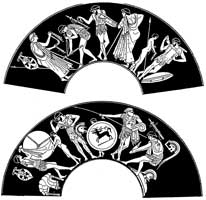
Stories
Three hundred Persian shields were send as a gift to the Athenians for the Parthenon by Alexander the Great displaying his victory over the Persian army.
Kephalos from Syracuse, the father of the Athenian orator Lysias was owner of a shieldfactory with 120 slaves. The father of Sophocles also is assumed to be a owner of a factory for armour.
Image of Achilles and Hector from the Achilleon (1892) , Shield Strap Fragment
Funny Images: Psykter, Hoplites Riding Dolphins
Types of Helmets , Corslets , Greaves
Image of the Helmet of Miltiades
COINS with Helmets and Shields
Messembria, Thrace, AR diobol, Facing Corinthian helmet. , Boetian Shield Circa 395/390-338 BC. AR Stater (from http://tjbuggey.ancients.info/Greek.html)
Becoming bullet proof Modern American Armor Technology
Physics meets archaeometry in ancient Greece , Death, glory and particle physics
Spartan Poet Tyrtaios:
It is beautiful when a brave man of the front ranks falls and dies, battling for his homeland, and ghastly when a man flees planted fields and city and wanders begging with his dear mother, aging father, little children and true wife. He will be scorned in every new village, reduced to want and loathsome poverty; and shame will brand his family line, his noble figure. Derision and disaster will hound him. A turncoat gets no respect or pity; so let us battle for our country and freely give our lives to save our darling children. Young men, fight shield to shield and never succumb to panic or miserable flight, but steel the heart in your chests with magnificence and courage. Forget your own life when you grapple with the enemy. Never run and let an old soldier collapse whose legs have lost their power. It is shocking when an old man lies on the front line before a youth; an old warrior whose head is white and beard is gray, exhaling his strong soul into the dust, clutching his bloody genitals in his hands--an abominable vision, foul to see--his flesh naked. But in a young man all is beautiful when he still possesses the shining flower of lovely youth. Alive he is adored by men, desired by women, and finest to look upon when he falls dead in the forward clash. Let each man spread his legs, rooting them in the ground, bite his teeth into his lips, and hold.
Nicolas Grguric, Angus McBride (Illustrator), The Mycenaeans C.1650-1100 BC (Elite S.) , Osprey Books (NY) (September 30, 2005) . ISBN: 1841768979
Tim Everson , Warfare in Ancient Greece : arms and armour from the heroes of Homer to Alexander the Great , Sutton Publishing 2005 ISBN 0750933186
John Warry, Warfare in the Classical World, An Illustrated Encyclopedia of Weapons, Warriors and Warfare in the Ancient Civilisations of Greece and Rome, London, Salamander Books Ltd, 1980
A.K.Goldsworthy "The Othismos, Myths and Heresies: The Nature Of Hoplite Battle ", War in history, Vol.4, No.1, 1997, P.1-26
Modern Hoplites Images

Hoplites in front of the tomb of the unknown soldier in Athens, Photo from Olvios, http://www.hoplites.net,
Part 1 - 2
| Ancient Greece
Science, Technology , Medicine , Warfare, , Biographies , Life , Cities/Places/Maps , Arts , Literature , Philosophy ,Olympics, Mythology , History , Images Medieval Greece / Byzantine Empire Science, Technology, Arts, , Warfare , Literature, Biographies, Icons, History Modern Greece Cities, Islands, Regions, Fauna/Flora ,Biographies , History , Warfare, Science/Technology, Literature, Music , Arts , Film/Actors , Sport , Fashion --- |

